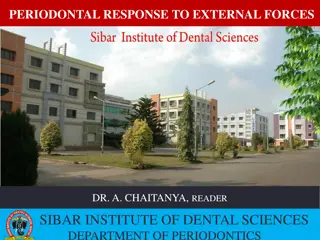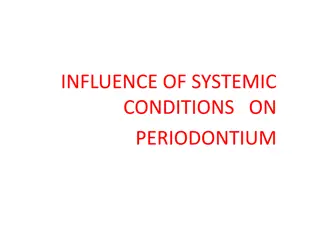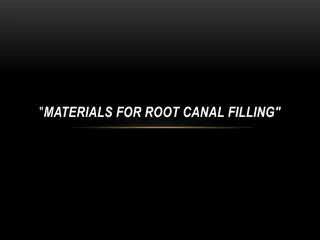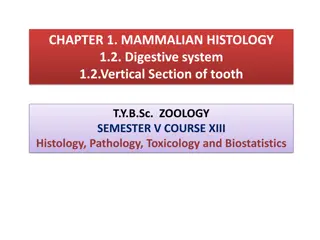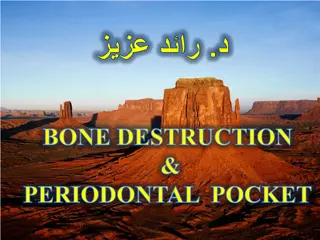Periodontal and Peri-Implant Surgical Anatomy Overview
Sound knowledge of the anatomy of the periodontium and surrounding tissues is essential for successful periodontal and implant surgical procedures. This includes understanding the mandible and maxilla anatomy, muscles, anatomic spaces, and landmarks like the mandibular canal. Proper awareness can he
9 views • 41 slides
Periodontal Response to External Forces in Periodontics
Adaptive capacity of the periodontium in response to occlusal forces is variable, influenced by factors like magnitude, direction, duration, and frequency. Trauma from occlusion occurs when occlusal forces exceed tissue's adaptive capacity, leading to tissue injury. It is classified into acute and c
0 views • 40 slides
Influence of Systemic Conditions on Periodontium
Systemic diseases, disorders, and conditions can affect the periodontium by impairing the host's barrier function and immunity, leading to periodontal destruction. Endocrine disorders like diabetes mellitus and hormonal changes, as well as female sex hormones during puberty, menstruation, pregnancy,
0 views • 20 slides
Understanding Materials Used for Root Canal Filling
The final step in endodontic treatment involves root canal filling, aiming to prevent exchange between the canal and periodontium. Pulpectomy is indicated for various dental conditions and is carried out in interim or permanent teeth. Different methods of devital extirpation are utilized in the proc
0 views • 16 slides
Mammalian Tooth Structure: Vertical Section Overview
Mammalian teeth consist of hard tissues (enamel, dentine, cementum) and soft tissue (tooth pulp). The enamel is the hardest, dentine surrounds the pulp cavity, and cementum covers the dentine and connects to the alveolar bone. Tooth pulp provides support, nourishment, and defense mechanisms. Support
1 views • 7 slides
Understanding Bone Destruction in Periodontal Disease
The progression of periodontal disease can lead to bone destruction in the alveolar bone, which is crucial in supporting teeth. The inflammatory process causes permanent damage to the periodontium tissues, resulting in connective tissue loss and bone resorption. Different patterns of bone loss, such
0 views • 14 slides

